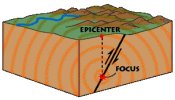
Worksheets and No Prep Teaching Resources
Reading Comprehension Worksheets
Earth Science

Earth Science
 Worksheets and No Prep Teaching Resources Reading Comprehension Worksheets Earth Science |
 Earth Science |
| edHelper's suggested reading level: | grades 8 to 9 | |
| Flesch-Kincaid grade level: | 8.19 |
|
When the Earth Hiccups
By Trista L. Pollard |

|
 1 Occasionally the Earth moves right underneath our feet. In some areas of our world, it moves enough to cause major damage. In other areas, the Earth merely hiccups. Earthquakes, according to seismologists, are movements of the ground caused by bursts of released energy. This energy is released when rocks move along faults. It is when these rocks are under stress that they suddenly move. Remember, faults are breaks in the bodies of rocks. Within these faults, the rocks slide in relation to other rocks.
1 Occasionally the Earth moves right underneath our feet. In some areas of our world, it moves enough to cause major damage. In other areas, the Earth merely hiccups. Earthquakes, according to seismologists, are movements of the ground caused by bursts of released energy. This energy is released when rocks move along faults. It is when these rocks are under stress that they suddenly move. Remember, faults are breaks in the bodies of rocks. Within these faults, the rocks slide in relation to other rocks. |
Create Weekly Reading Books
Prepare for an entire week at once! |
| Leave your feedback on When the Earth Hiccups (use this link if you found an error in the story) |
 |
Earth Science
|
 |
High School Reading Comprehensions and High School Reading Lessons
|